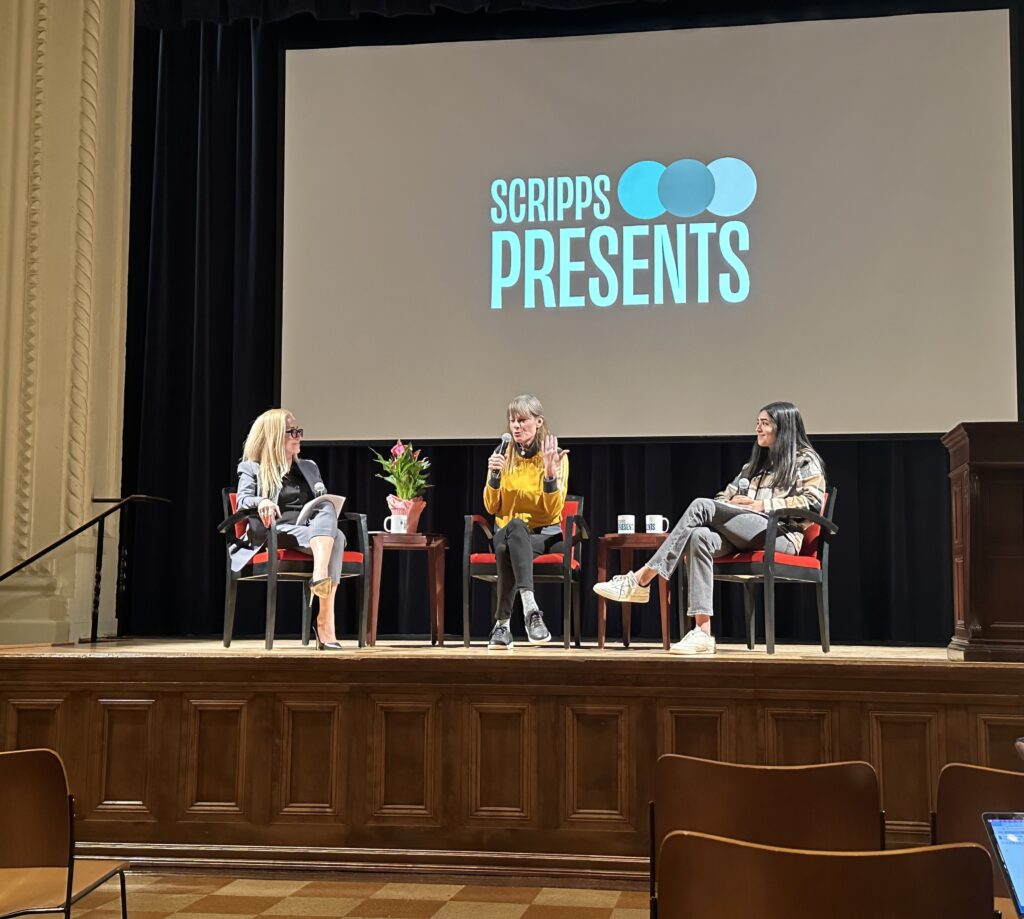Zoe Tomlin ’27
Staff Writer
On Feb. 8, Scripps Presents welcomed Jessica Bendinger, a screenwriter, director, and producer, to the Balch Auditorium stage for a discussion with Jackie Yedgar, the Assistant Director of Events and Conference Services at Scripps, and Kaavya Narayan CMC ’25.
Though her career has spanned far and wide, Bendinger is best known for having written the screenplays for Bring It On and Stick It, as well as writing for the fourth season of Sex and the City. She is also an author and published her first novel, The Seven Rays, in 2009. Throughout the conversation, Bendinger held the audience’s attention with her thoughtful responses peppered with witty observations and a spirited presence.
Yedgar began the evening by sharing her insight into Bendinger’s character. “In case you’re wondering what it’s like to be friends with Jessica … it is the equivalent of riding shotgun with a Formula One driver,” she said. This earned a warm laugh and as the night continued with Bendinger’s stories, Yedgar’s statement rang more and more true.
Narayan commenced the questioning by asking Bendinger about her movement into the world of storytelling. As an only child of divorced parents, Bendinger noted that she often felt like “a plus one that nobody wanted … bopping around from place to place.” To cope with her uncomfortable circumstances, she learned to “read the context,” ensuring that she was able to find her proper role in each situation.
Bendinger was constantly considering people and places and attempting to fully understand the inner workings of others’ minds. Writing, for Bendinger, was merely the next logical step in her system of observation.
Storytelling served as a portal into lives distinct from her own – a way to escape, but also to continue her habit of empathy. “Writing felt like the opportunity to be a fly on the wall [in] anybody’s life, rather than just my own,” she said.
Furthering her ideas on storytelling, Bendinger spoke about what spurred her to write Bring It On, the story of a high school cheerleader. She recalls being a young girl in the 1970s, seeing cheerleaders for the first time, and being in awe of their ability to “[command] the attention of everybody in the room … I couldn’t imagine a world in which young women commanded the attention of the adults.”
Similar moments piqued Bendinger’s interest, leading her to contemplate the people behind the pompoms and cheer routines while wondering how they experienced life. Storytelling allowed her to take those curiosities and dive deeper – creating characters and stories that would “build a bridge between the audience and [a character’s] experience.”
And, if there was one thing that Bendinger could do, it was crafting a powerful bridge – one that encourages genuine empathy, fun, and connection.
Bring It On debuted at the top of the box office and remained there for two weeks. Despite the film’s considerable success, Bendinger remembers struggling to get her foot in the door of Hollywood. She pitched her screenplay 28 times over the course of two months, experiencing rejection after rejection.
Eventually, Bendinger realized that “she [had been] walking into rooms of men who [did] not understand young women and did not care about young women as audiences.” The stories Bendinger was pitching often did not align with the “lived experiences” of the people with whom she was sharing them so it was up to her to convince them that stories directed toward young women had value.
This was easier said than done. Though she recognized the intrinsic worth of her stories, Bendinger realized that the only way to garner support from the men of Hollywood was to convince them of their monetary value. She found if she could provide statistics proving the demand for media centering cheerleading and gymnastics, among other things, she would be taken more seriously.
While this was and is an unfortunate product of the male-dominated reality in which we live, it is also a testimony to Bendinger’s intelligence and determination. She prioritizes telling the stories that she feels need to be told, refusing to default to what may be most palatable to a larger audience or what will sell at the box office.
Authenticity is a key component of Bendinger’s storytelling. For her, writing is personal, and in order to create a relatable piece of work, it must remain that way — intimate and vulnerable.
As a result, she focuses on experiences that will genuinely speak to certain groups of people – to her, taking the risk of vulnerability is what generates a meaningful story. “When you tell a story for everyone, it ends up being for no one,” Bendinger said.
Image Source: Zoe Tomlin ‘27



